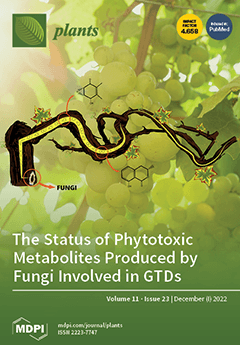Propolis is a resinous mixture of substances collected and processed from various botanical sources by honeybees. Black poplar (
Populus balsamifera L.) buds are one of the primary sources of propolis. Despite their reported therapeutic properties, little is known about the innate immunomodulatory activity of essential oils from
P. balsamifera and propolis. In the present studies, essential oils were isolated from the buds of
P. balsamifera and propolis collected in Montana. The main components of the essential oil from
P. balsamifera were
E-nerolidol (64.0%), 1,8-cineole (10.8%), benzyl benzoate (3.7%), α-terpinyl acetate (2.7%), α-pinene (1.8%), o-methyl anisol (1.8%), salicylaldehyde (1.8%), and benzyl salicylate (1.6%). Likewise, the essential oil from propolis was enriched with
E-nerolidol (14.4%), cabreuva oxide-VI (7.9%), α-bisabolol (7.1%), benzyl benzoate (6.1%), β-eudesmol (3.6%), T-cadinol (3.1%), 2-methyl-3-buten-2-ol (3.1%), α-eudesmol (3.0%), fokienol (2.2%), nerolidol oxide derivative (1.9%), decanal (1.8%), 3-butenyl benzene (1.5%), 1,4-dihydronaphthalene (1.5%), selina-4,11-diene (1.5%), α-cadinol (1.5%), linalool (1.4%), γ-cadinene (1.4%), 2-phenylethyl-2-methyl butyrate (1.4%), 2-methyl-2-butenol (1.3%), octanal (1.1%), benzylacetone (1.1%), and eremoligenol (1.1%). A comparison between
P. balsamifera and propolis essential oils demonstrated that 22 compounds were found in both essential oil samples. Both were enriched in
E-nerolidol and its derivatives, including cabreuva oxide VI and nerolidol oxides.
P. balsamifera and propolis essential oils and pure nerolidol activated Ca
2+ influx in human neutrophils. Since these treatments activated neutrophils, the essential oil samples were also evaluated for their ability to down-regulate the neutrophil responses to subsequent agonist activation. Indeed, treatment with
P. balsamifera and propolis essential oils inhibited subsequent activation of these cells by the
N-formyl peptide receptor 1 (FPR1) agonist
fMLF and the FPR2 agonist WKYMVM. Likewise, nerolidol inhibited human neutrophil activation induced by
fMLF (IC
50 = 4.0 μM) and WKYMVM (IC
50 = 3.7 μM). Pretreatment with the essential oils and nerolidol also inhibited human neutrophil chemotaxis induced by
fMLF, again suggesting that these treatments down-regulated human neutrophil responses to inflammatory chemoattractants. Finally, reverse pharmacophore mapping predicted several potential kinase targets for nerolidol. Thus, our studies have identified nerolidol as a potential anti-inflammatory modulator of human neutrophils.
Full article






